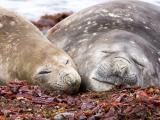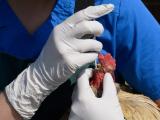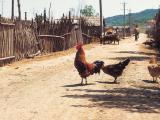Nov 16, 2007 (CIDRAP News) – An analysis of influenza viruses collected from North American migratory birds over a 6-year period suggests that wild birds rarely carry avian flu viruses between Eurasia and North America, implying that the risk of the deadly H5N1 virus reaching the Americas by that route is probably low.
A team of American and Canadian researchers based that conclusion on a study of 248 complete avian flu viruses and several thousand gene segments of flu viruses collected from birds in Alberta and on the New Jersey coast from 2001 through 2006. Their report, with Scott Krauss of St. Jude Children's Research Hospital in Memphis as lead author, was published this week by PLoS Pathogens. The senior author is leading flu researcher Dr. Robert Webster, also of St. Jude.
"Genomic analysis of influenza viruses from our repository failed to provide evidence of influenza viruses with their whole genome originating from Eurasia," the report states. "However, we found occasional influenza viruses from North America with single or multiple genes that originated in Eurasia. Our interpretation is that while influenza viruses do exchange between the two hemispheres, this is a rare occurrence."
The researchers say the highly pathogenic (HP) H5N1 virus has a better chance of reaching the western hemisphere via birds moved by humans than via wild birds. Nevertheless, careful surveillance of wild birds in the Americas should continue, they add.
The possible role of migratory birds in spreading the HP H5N1 has long been debated. Thousands of migratory birds died of H5N1 disease in 2005 at the Qinghai Lake wildlife sanctuary in China, a major gathering place for migratory birds, and that outbreak is suspected to have played a role in the subsequent spread of the virus to central Asia, the Middle East, Europe, and Africa.
Scientists at a United Nations Food and Agriculture Organization (FAO) conference last year in Rome agreed that wild birds played some part in spreading the H5N1 virus for long distances. But the FAO said the experts couldn't agree on exactly how the virus had reached more than 50 countries on three continents or whether wild birds provide a permanent reservoir for the virus.
A US testing program for HP H5N1 in wild birds over the past 2 years has revealed no signs of the virus so far. About 109,000 birds were tested from April 2006 through March of this year, according to previous reports from the US Department of Agriculture and the Department of the Interior. A low-pathogenic North American strain of H5N1 virus has been found in a few birds in the United States. Canadian surveys in 2006 and 2007 have found no highly pathogenic viruses either.
Two avian flu 'superfamilies'
The St. Jude research team sought to investigate why the HP H5N1 virus has not reached the Americas even though the migratory paths of wild birds from both hemispheres overlap in places like Alaska.
The report says genetic studies of flu viruses from wild birds have shown they generally fall into two "superfamilies"—American and Eurasian—which implies that the transfer of whole viruses between the eastern and western hemispheres is infrequent.
The study included collection of cloacal and blood samples from wild ducks in Alberta and of fecal samples from shorebirds (including gulls) on Delaware Bay in New Jersey. Surveillance of wild birds in the two areas had been ongoing since 1976 and 1985, respectively.
The researchers found influenza A viruses in 98 (16.6%) of 590 cloacal samples from the ducks and in 114 (5.8%) of 1,970 samples from shorebirds. Fourteen of the 16 known hemagglutinin (H) subtypes were represented (H1-H13, H16), as were all nine of the neuraminidase (N) subtypes. The most common subtypes in ducks were H4N6, H1N4, and H10N7, while the most common in shorebirds were H10N7, H1N9, and H7N3. No H5N1 subtypes were found. In addition, serologic studies of blood samples gathered from about 700 Alberta ducks in 2004, 2005, and 2006 revealed no evidence of HP H5N1 infection.
The findings also included 27 H7 viruses, 24 of which were H7N3, collected from the shorebirds in 2006. Testing in chickens showed the H7N3 viruses were nonpathogenic—unlike the H7N3 strain that caused a poultry outbreak in British Columbia in 2004—but the viruses replicated in the chickens and were lethal to chicken embryos.
In their genetic analysis, the authors examined 6,767 gene segments (which had been described in an earlier study by a St. Jude team) and 248 complete genomes. They found a low rate of "outsider events"—gene segments belonging to one superfamily (Eurasian or American) occurring in viruses from the other superfamily. Overall, 56 (0.83%) of the 6,767 gene segments analyzed were classified as "outsiders," and none of the 248 complete genomes represented a transfer from one superfamily to the other.
"Based on these studies, it is more likely that the Asian H5N1 viruses will be imported into the Americas with birds moved legally or illegally by humans," the article states.
Surveillance of migratory waterfowl has shown that many species can be infected with the deadly H5N1 virus, but there is no evidence that they become long-term carriers that "perpetuate" it, the researchers say. Instead, they write, evidence indicates that domestic ducks and geese often carry the virus despite apparent health, and in the cooler months the virus "spills over" into other poultry and migratory birds.
The authors conclude that the results of their genetic studies and the lack of evidence for H5N1 perpetuation in wild birds "make the probability of introduction of HP H5N1 into the Americas by migratory birds an unlikely event."
Other experts' views
Other wildlife-disease experts who were not involved in the study voiced general agreement with the findings and conclusions.
David E. Stallknecht, PhD, of the University of Georgia in Athens, said the findings agree with previous research on the risk of HP H5N1 reaching the Americas via wild birds. Stallknecht is an associate professor with the Department of Population Health and the Southeastern Cooperative Wildlife Disease Study in the university's College of Veterinary Medicine.
"The results are not unexpected based on similar work that is already in the literature," he told CIDRAP News. "These [previous] results probably provided the best evidence that the probability of HPAI (HP avian influenza) H5N1 moving to North American via wild birds was slim at best."
In view of the other research results, including the failure to find HP H5N1 in more than 400,000 healthy wild birds tested to date and field evidence from outbreaks in Europe, Stallknecht said, "I certainly agree with the conclusion presented in this manuscript."
Dr. Patrick Redig, associate professor in the College of Veterinary Medicine and director of the Raptor Center at the University of Minnesota in St. Paul, called the report by Krauss and colleagues "a very important paper." Because it is based on surveillance that goes back a number of years, it "provides historical evidence about various influenza viruses that predates all the buzz about H5N1," and it corroborates the recent large-scale testing of wild birds by the Canadian and US governments, he said.
"It clearly establishes that the likelihood of the entire HP H5N1 virus being introduced into the Americas by wild waterfowl or shorebirds would be an extremely unlikely event, given the historical patterns of transfer," Redig added. He said the study leaves open the possibility that pieces of H5N1 genetic material could turn up in viruses in the North American superfamily, "but again it would be a rare event."
On the other hand, Redig said, "I think the paper does underplay the survival of the HP H5N1 in wild birds, given the continuing movement and introduction of the virus into various areas in Europe, particularly the latest outbreak in Suffolk, UK, and another in Saudi Arabia. While it remains to be seen if either of these can be tracked back to wild birds, there is a suggestion that the probability is not zero."
David A. Halvorson, DVM, a veterinary pathologist and avian flu expert at the University of Minnesota in St. Paul, agreed that the new study findings match up with previous findings. "This research reinforces what has been published before, that New World and Old World avian influenza viruses are distinct lineages with only occasional introduction of old world AI virus genes into new world AI viruses," he said.
Krauss S, Obert CA, Franks J, et al. Influenza in migratory birds and evidence of limited intercontinental virus exchange. PLoS Pathogens 2007 Nov;3(11) [Full text]
See also:
Aug 30, 2006, CIDRAP News story "Tests find no H5N1 avian flu in Alaskan birds"
May 7 CIDRAP News story on US testing of wild birds in 2007
Jun 2, 2006, CIDRAP News story "FAO: Wild birds play role in avian flu, but poultry key"
Feb 10, 2006, CIDRAP News story on study suggesting that wild birds can carry H5N1 long distances



















